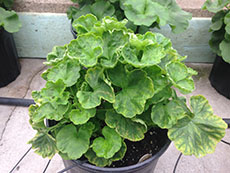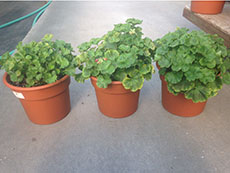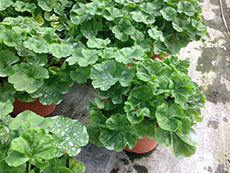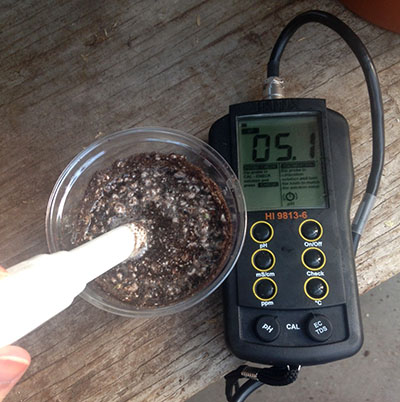Low pH induces iron and manganese toxicity in geraniums
Zonal geraniums with low pH can exhibit iron and manganese toxicity symptoms, including marginal chlorosis, leaf speckling and upward-cupping of the leaves.

Many growers have reported their zonal geraniums are exhibiting symptoms of iron and manganese toxicity (Photos 1-4). The pH of one geranium sample had a pH of 5.1 (Photo 5). The increased prevalence of this problem can be at least partly attributed to starting with media with a low pH (4.0 to 5.3).
Michigan State University Extension recommends to continuously monitor the pH and EC of crops so trends or problems can be detected early. Growers should also calibrate pH meters prior to first use during the season. Now, let’s review the answers to some commonly asked questions.
What substrate pH is recommended for zonal geraniums?
The ideal pH for growing zonal geraniums is between 6.0 and 6.5. They are the “poster child” of plants that readily absorb iron and thus are referred to as “iron efficient” crops. In contrast, other crops such as petunia and calibrachoa are “iron inefficient” and require a lower substrate pH of 5.5 to 5.8 to prevent an iron nutrient deficiency.
What symptoms do you see when the pH of the substrate is too low?
- Brown speckling of leaves, especially towards the outer margin.
- Leaf chlorosis or yellowing around the edges.
- Upwards cupping of leaves in some varieties.
- Stunted growth.


Photos 2-4. Zonal geraniums at two different greenhouse businesses exhibiting iron and manganese toxicity symptoms caused by a low pH of the growing media.
How can I increase media pH quickly to prevent toxicity symptoms on new growth?
Greenhouse growers can increase the substrate pH by drenching with a suspended limestone (flowable lime), potassium bicarbonate or calcium carbonate (such as CalOx). The recommended rates will strongly depend on your initial pH. Drenching the growing media with one of these products is generally only recommended if the pH of the substrate is excessively low (less than 5.5). To learn more, check out these recent MSU Extension articles:
- Different types of limestone to increase substrate pH
- Testing and corrective procedures for low substrate pH
- Commonly used limestones for adjusting pH in greenhouse mixes
If the pH is only slightly lower than recommended (5.6 to 5.9), consider changing to a more alkaline fertilizer; for example, 15-0-15 or 14-2-14. Growers who have highly alkaline water and normally inject acid to neutralize the bicarbonates could stop acidification to raise the pH of the media. However, these strategies can be difficult to implement when growing a wide variety of iron efficient and iron inefficient crops together.
Photo 5. According to a saturated media extract pH test, the pH of the substrate of a zonal geranium exhibiting iron and manganese toxicity symptoms was 5.1.
What should I do if some geraniums have a low pH while others in the greenhouse do not?
We recommend growers sort out the geraniums that are exhibiting iron and manganese toxicity symptoms and have a low pH from those that are not. Because the growing media pH may have varied between bales, some growers are seeing that only some plants are exhibiting symptoms. Growers should apply a corrective drench only to those plants with a low pH.
Read this article by Paul Fisher (University of Florida) and Bill Argo (Blackmore Co.) for more detailed information: “Iron-Out”: A nutritional program for geraniums and other crops prone to iron and manganese toxicity at low media-pH. Pages 8–10 contain the most relevant information to raise the media pH.



 Print
Print Email
Email






